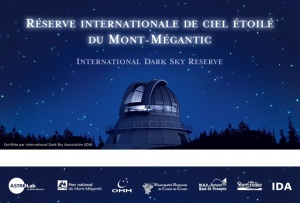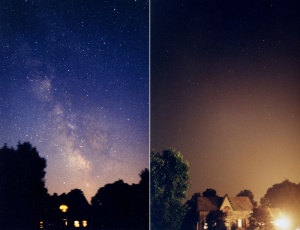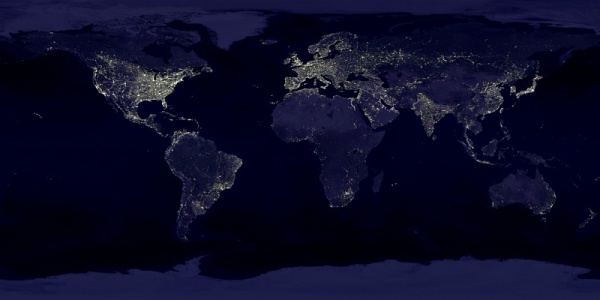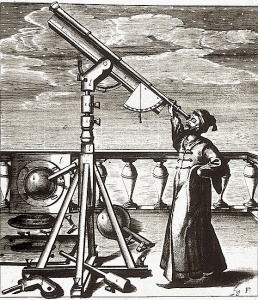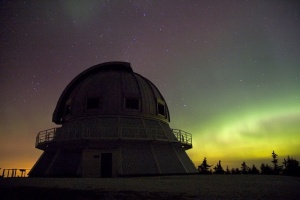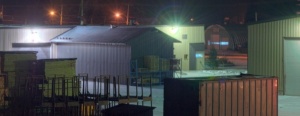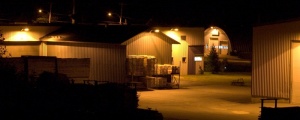Mont-Mégantic International Dark Sky Reserve
par Legris, Chloé
The Mont-Mégantic region was recognised as the first international dark sky reserve in September of 2007 by the International Dark Sky Association. The certification recognises leadership of the region in regards to the preservation and restoration of the darkness of the starlit sky, which is one of the region's main natural treasures. The ASTROLab, observatory and the Parcs Quebec united their efforts to set up a dark sky reserve project, which included an awareness campaign, the adoption of regulations in 34 municipalities and an ambitious program to reduce light pollution, in order to preserve the quality of the night sky in the region. The project ensures that research, education, and tourist activities at Mont Mégantic will continue, thanks to the effective control of light pollution. The region currently preserves an official piece of scientific, cultural and environmental heritage.
Article disponible en français : Réserve internationale de ciel étoilé du Mont-Mégantic
A New Kind of Pollution: Light!
Until the 19th century, nocturnal lighting was provided by the moon, torches and small lanterns. Since then, the invention of electricity and the installation of outdoor urban lighting have led to the development of permanent artificial nocturnal lighting systems that, with time, generated ever-increasing amounts of light pollution. The term Light Pollution refers to the way in which any modification to the natural nocturnal environment caused by artificial lighting and any negative effect caused by the inadequate or abusive use of such lighting systems. There are multiple negative consequences including the obscuring of starlit sky, hiding of nocturnal landscape, deregulation of ecosystems (due to interrupted bio-rhythms), glare, intrusive light, and increased energy consumption.
It is estimated that light pollution has increased exponentially (NOTE 1) over last few decades, so much so that night sky is at risk of disappearing completely in most industrialized societies.
The Starry Sky Hidden in a Veil of Light
Obscuring our view of the stars is one of the most significant consequences of light pollution. This pollution disturbs the work of astronomers and deprives stargazers of the visual spectacle of a star-filled sky and a beautiful nocturnal landscape. Today we have to travel several hundreds of kilometres outside of urban centres, in order to properly view the Milky Way. In major urban centres around the world, close to 97% of stars are no longer visible. For example, in the night sky in the Montreal region, only around a hundred stars are visible. However, in the Mont-Mégantic region, it's possible to perceive over 3000 stars with the naked eye.
Aside from the fact that the star-filled skies are disappearing in industrialised societies, light pollution also degrades the nocturnal landscape considerably. To the disappointment of many night-time enthusiasts, night time has become a continuation of twilight and the horizon has become a blurred haze with scattered lights. This would bother anyone who might wish to take a moonlit stroll.
Night is Essential for Life
Throughout history, living beings have been able to take advantage of the benefits of both day and night, light and dark. It is not surprising that light pollution, which is essentially causing the night to disappear, can have severe negative consequences on human health and on ecosystems. The loss of the day/night cycle (circadian rhythm) and the presence of artificial light can have numerous negative consequences. Some consequences are listed below:
- Production of certain hormones is inhibited, e.g., melatonin. This hormone is produced uniquely during the night and its production is inhibited in the presence of light. Melatonin helps to limit the growth of certain cancer cells and its absence is also linked to various sleeping disorders in humans;
- Disturbance of nocturnal habits in most animals leads to them leaving their natural habitat;
- Insects which are attracted to light are often killed by bare light bulbs or are eaten by predators that are able to find them more easily. This causes disequilibrium in the food chain.
Though there is still a lot of research left to be done, it is clear that the scientific communities, which specialise in biology, ecology, chronobiology and endocrinology, are studying this phenomenon with more interest than ever before (NOTE 2). Night time is indeed disappearing in industrialised societies and, as a result, numerous problems (which are still largely misunderstood) are linked to this major change.
Increased Energy Consumption
In North America, the energy costs incurred to needlessly illuminate the sky every year is close to a billion dollars. This energy is wasted and adds to greenhouse gas emissions when electricity is produced by burning fossils fuels, which is usually the case.
Quebec is the geographic area that is reputed for generating the most light per capita in the world. In the province, the savings that could result from better management of lighting are estimated at 700 Gigawatt-hours annually. This is equivalent to the annual consumption of approximately 20,000 electrically heated houses.
The Nocturnal Environment: a Part of our Heritage
Since the beginning of time, the night sky has fascinated and inspired humans. Contemplating the sky was an essential component in the evolution of civilisations, in addition to being a major source of our understanding of the universe. Observing the night sky has greatly contributed to the progress of science and technology and has also been a source of inspiration for poets, painters, philosophers, and all kinds of thinkers and artists. The following are a few quotes by famous people:
- But now the sight of day and night, and the months and the revolutions of the years, have created number, and have given us a conception of time. Plato
- Through space, the universe encompasses and swallows me up like an atom; though through thought I comprehend the world. Pascal
- The world embarrasses me, and I cannot dream that this watch exists and has no watchmaker. Voltaire
- If you love a flower that lives on a star, it is sweet to look at the sky at night.The Little Prince
- The most beautiful emotion we can experience is the mysterious. It is the fundamental emotion that stands at the cradle of all true art and science. Albert Einstein
- Every one is a moon, and has a dark side which he never shows to anybody. Mark Twain
- "Human beings are aware of the universe that surrounds them and are amazed by its order and its beauty" Hubert Reeves
Astronomy, mother of all sciences because it is the oldest, allows us to contextualize ourselves in regards to time (e.g., calendars, seasons, agriculture) and space (e.g., exploration, hunting, navigation). Our knowledge of astronomy has enabled us to understand:
- That the Earth is round and that we are not the centre of the universe ;
- Where we live (solar system and galaxy);
- The history of the universe (our history!);
- How to interpret the evolution of climate, which plays a fundamental role in the lives of human beings.
According to Steve Maclean, astronaut with the Canadian Space Agency, every dollar invested in astronomy generates ten dollars in economic fallouts, as a result of the development of technological expertise that benefits the private sector. For example, the technological innovations linked to optics and digital imaging (Charge-coupled device: CCD) are largely a consequence of astronomical research and development.
Astronomy is a science that, even today, captures the interest of everyone, great and small, with its numerous theoretical and practical ramifications. However, access to this "celestial treasure" and the possibility of being able to freely observe the heavens is being threatened by the gradually diminishing night sky. Everywhere in the world, astronomers were among the first to sound the alarm regarding light pollution-a problem caused by poor energy use management. The quality of the night sky has been deteriorating at an astonishing rate for the last twenty years. This deterioration has caused many countries and international organizations to consider the nocturnal environment and the night sky as an integral part of the world's natural heritage, which must be preserved.
Mont Mégantic International Dark Sky Reserve
Between 2003 and 2009, the Mont-Mégantic ASTROLab headed up a project to fight against light pollution in the surrounding regions, in order to preserve the darkness and quality of the night sky, as well as to ensure the sustainability of research activities, education and tourism in the region.
Because many of the Mont-Mégantic area's activities depend on astronomical observation, protecting the night sky is of crucial importance in the region. Furthermore, its remote location does not necessarily protect it from light pollution. In fact, light pollution at the ASTROLab has more than doubled from 1978 to 1998. When it was constructed in 1979, the brightness of the night sky was 25% brighter than its natural state whereas in 1998 it was 50% brighter than in its natural state. This means it was twice as bright in 1998 than in 1979. An annual increase in light pollution between 5 and 10% put the scientific usefulness of the location at risk and jeopardised the viability of the ASTROLab. This is the reason why the dark sky reserve project was developed.
Thanks to an ambitious action plan focusing on awareness, municipal regulations and light conservation, in September of 2007, the International Dark Sky Association officially recognised the region as the first Dark Sky Reserve in the world.
The Mont-Mégantic Reserve covers an area of about 5,500 km² and includes 34 municipalities. It is centered in the national park at the Observatoire du Mont-Mégantic, which takes in everything within a 50-km radius of the observatory. It also includes the city of Sherbrooke located 60 km (in a strait line) from the observatory. The zones of intervention were determined based on their respective impacts on light pollution as measured at the summit of Mont-Mégantic.
Efforts were made to educate and inform the public concerning the problems associated with light pollution, as well as benefits of reducing it. The information was distributed to virtually everyone, including the government, the general population, politicians, manufacturers, distributors, urban planners, architects, engineers, electricians, etc. Numerous meetings were held with political decision makers and informative sessions were offered to those involved in various lighting installations. Major resources and efforts were invested in developing public relations with the various parties involved, using different media available. As a result of the collective success of these various activities, the region was able to restore its marvellous natural heritage-the clarity and brilliance of the night sky.
It was essential to make the public and the parties involved aware of the ramifications of the changes before having the 34 municipalities of the newly proposed reserve adopt the new regulations. Between 2005 and 2007, each of the administrative districts involved (otherwise known as MRC or Municipalités Régionales de Comté), progressively began to pass and enforce the new legislation. Although the regulations were not retroactive, they guaranteed sufficient measures would be taken to ensure the energy efficiency of all future installations. It was necessary to enact these regulations before the launching of a major private and public and light conservation program. Under the program, 3,300 lights determined to be inadequate or excessive were replaced in the conservation zone. In addition to reducing light pollution by around 25%, the initiative saved 1,800,000 kilowatt-hours of energy per year.
Many positive comments were received by researchers at the observatory and from residents of the region. The founder of the ASTROLab, Bernard Malenfant was very enthusiastic in his remarks: "We no longer see illuminated domes over these municipalities when the sky is overcast. We also have to get back into the habit of walking around the observatory with a flashlight. It's incredible! I am able to re-experience the night sky, just as it was 30 years ago!"
Good Lighting Practises
The regulations regarding night time lighting and the light abatement program put in place on the reserve is based on four principles, which encourage the following:
- The use of efficient light bulbs that reduce light emitted into the sky (NOTE 3);
- The use of fixtures that offer optimal control of light, thereby directing it toward the ground and not into the sky;
- The use of appropriate lighting, thereby avoiding excessively bright lights;
- Restricting of the time of day when lighting is used.
However, before lights can be added or removed, it is necessary to evaluate the real needs a particular installation requires. Night lights help people to see and to be seen, but it is also important to inquire as to whether a particular location needs a light. When it is determined to be necessary, then it is imperative to ask the following questions:
- What surfaces or what objects need to be illuminated?
- How much intensity is required?
- When is illumination required and is it required at all times?
In order to produce efficient, safe, efficient, quality lighting, it is necessary to eliminate all forms of glare that can result. Glare is produced when the eyes are exposed to intense light (e.g., bare bulbs, or lighting that is too bright or inadequately positioned for the installation needed) that causes the pupil to close or when there is a sharp contrast between the main areas of lighting and darker areas. Visual perception is optimal when lighting is uniform and it also reduces glare. The lighting offered by a full moon is a prime example of this and illustrates the balance required. Such lighting is dim, but uniform without any glare. The eye adapts to its environment, which allows it to see clearly.
The modifications made in the Mont-Mégantic region were generally well received without sacrificing the local population's feeling of security. The lighting is now softer and less aggressive, which allows some streets and businesses in small towns to appear to be veiled at night. From a distance, the luminous domes over some towns have virtually disappeared and the night sky is more magnificent than ever before!
An Example to Follow
The preservation of night time darkness is a growing concern around the world. The Mont-Mégantic region is among the first in the world with the will to protect natural darkness, while still respecting the safety and security of its inhabitants. Let's hope that the region will be an example that will influence others!
Chloé Legris, Eng.
Mont-Mégantic ASTROLab
NOTES
Note 1. Research carried out by Pierantonio Cinzano, of the Crescita dell'Inquinamento Luminoso [Institute of Science and Technology of Light Pollution]. Web link to an article on his research: http://www.lightpollution.it/cinzano/en/page94en.html
Note 2. For more information, "Ecology of the Night"
http://www.urbanwildlands.org/ecanlbook.html is a literary revue of research
done on the subject. The summary can be read in the publication
"Ecological Light Pollution"
http://www.astrolab-parc-national-mont-megantic.org/files/pollution_lumineuse/LongcoreRich2004.pdf
in the review "Ecological Society of America". A series of articles
on health and sleeping difficulties can be found on ASTROLab's website : http://www.astrolab-parc-national-mont
megantic.org/files/pollution_lumineuse/Article_IDA.pdf
Note 3. Certain types of light bulbs are forbidden, but others are tolerated if their intensity is weak. White light, such as those emitted by mercury bulbs or metallic halogens, has a higher ratio of blue wavelengths. These wavelengths are reflected in the atmosphere four times more than wavelengths emitted by yellow light (e.g., high-pressure sodium). White light has a bigger impact on the night sky and greatly hinders star observation.
Additional DocumentsSome documents require an additional plugin to be consulted
Images
-
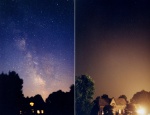 Banlieue de Toronto,
Banlieue de Toronto,
sans et avec éc... -
 Carte des trois zones
Carte des trois zones
d’intervention... -
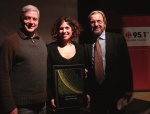 Chloé Legris, en comp
Chloé Legris, en comp
agnie de Charle... -
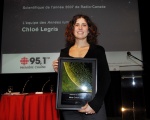 Chloé Legris, récipie
Chloé Legris, récipie
ndaire du prix ...
-
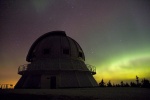 L’observatoire du Mon
L’observatoire du Mon
t-Mégantic -
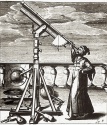 Le téléscope de Hevel
Le téléscope de Hevel
ius -
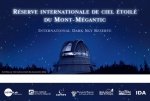 Panneau de la Réserve
Panneau de la Réserve
internationale... -
 Pollution lumineuse d
Pollution lumineuse d
ans le monde
-
 Pollution lumineuse t
Pollution lumineuse t
elle que vue du... -
 Scierie Ditton après
Scierie Ditton après
le programme de... -
 Scierie Ditton avant
Scierie Ditton avant
le programme de... -
 Village de La Patrie
Village de La Patrie
après la conver...

